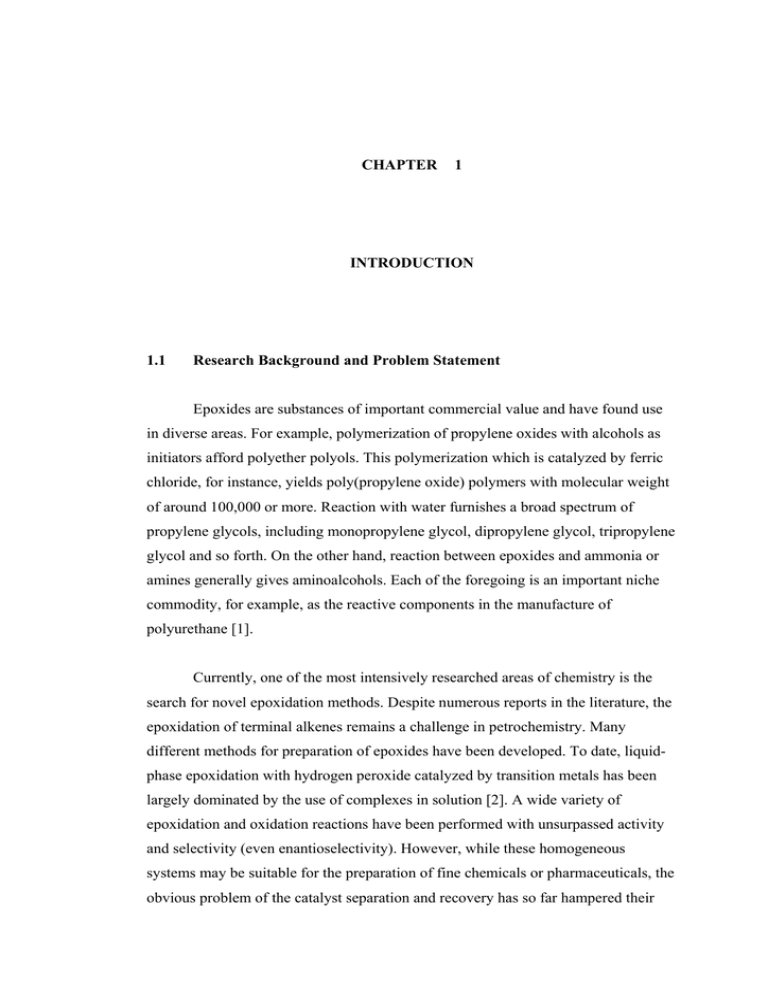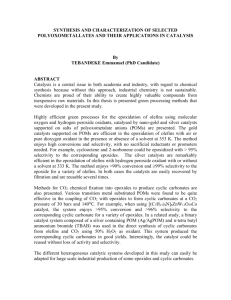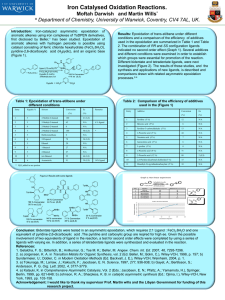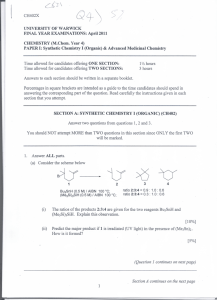Epoxides are substances of important commercial value and have found... in diverse areas. For example, polymerization of propylene oxides with... CHAPTER 1
advertisement

CHAPTER 1 INTRODUCTION 1.1 Research Background and Problem Statement Epoxides are substances of important commercial value and have found use in diverse areas. For example, polymerization of propylene oxides with alcohols as initiators afford polyether polyols. This polymerization which is catalyzed by ferric chloride, for instance, yields poly(propylene oxide) polymers with molecular weight of around 100,000 or more. Reaction with water furnishes a broad spectrum of propylene glycols, including monopropylene glycol, dipropylene glycol, tripropylene glycol and so forth. On the other hand, reaction between epoxides and ammonia or amines generally gives aminoalcohols. Each of the foregoing is an important niche commodity, for example, as the reactive components in the manufacture of polyurethane [1]. Currently, one of the most intensively researched areas of chemistry is the search for novel epoxidation methods. Despite numerous reports in the literature, the epoxidation of terminal alkenes remains a challenge in petrochemistry. Many different methods for preparation of epoxides have been developed. To date, liquidphase epoxidation with hydrogen peroxide catalyzed by transition metals has been largely dominated by the use of complexes in solution [2]. A wide variety of epoxidation and oxidation reactions have been performed with unsurpassed activity and selectivity (even enantioselectivity). However, while these homogeneous systems may be suitable for the preparation of fine chemicals or pharmaceuticals, the obvious problem of the catalyst separation and recovery has so far hampered their 2 use in larger scale operations. In most cases, separation difficulties have been the key barrier to commercialization of delicate synthetic chemical methodologies. Hence, the heterogeneous catalytic system offers a better alternative nowadays since it is safer, possesses higher efficiency and environmentally acceptable which eventually reduces plant maintenance and minimizes environmental problems. The breakthrough invention of titanium-silicalite-1 (TS-1) by Taramasso et al. opened a new route for the synthesis of epoxides heterogeneously[3]. TS-1 catalyses the epoxidation of alkenes with diluted hydrogen peroxide with high conversion rates and selectivity under mild conditions in the liquid phase. TS-1 has unique catalytic properties, being effective in oxidation of a variety of organic compounds at low temperature, using diluted hydrogen peroxide as oxidant for the epoxidation of alkenes [4], epoxidation of allylic alcohols [5], oxidation of alkanes [6], hydroxylation of aromatics [7], and ammoximation of ketones [8]. Although TS-1 exhibits remarkable reactivity, by-products are formed in consecutive reactions such as the solvolysis of epoxides. This is quite a serious problem where the epoxides are the desired products. Moreover, one of the main difficulties in the use of TS-1 is the complexity in its synthesis process. Subsequent to the weaknesses of TS-1, a large volume of works has been carried out on titanium-incorporated ordered mesoporous silica [9, 10], titanium silica-supported catalysts [11, 12], and amorphous titania-silica aerogels. The epoxidation of a range of alkenes was shown to proceed in excellent conversions and almost complete selectivity. A common and major claim of all these works is the excellent performance of these catalysts in the epoxidation reactions of the olefinic substrates with alkyl hydroperoxide as oxidant, for instance, tert-butyl hydroperoxide (TBHP). Despite good activity with alkyl hydroperoxides, however, they are in general fail to promote epoxidations with hydrogen peroxide because of their surface hydrophilicity properties compared to the hydrophobic silicalites. Hydrophilicity of catalyst hampers the diffusion of organic substrates inside the pores or surface of the solid. This becomes a major hurdle that prevents the practical use of aqueous hydrogen peroxide. In order to modify the surface hydrophobicity/ hydrophilicity, several reports have been documented: methylation by Klein and Maier [13], 3 modification with covalent chloride ligands by Neumann and Levin-Elad [14], and partial octadecylsilylation by Ohtani, Ikeda and Hadi [15, 16, 17]. In our study, however, zirconia has been employed to act as the host for the epoxidations. The zirconia proved to provide a suitable environment for the reaction to take place without the incursion of significant side-reactions. One of the main reasons that zirconia is selected as the host material is its ultra-stability towards chemical modification. Zirconia structure remains intact even under modification with strong acid, for instance, hydrochloric acid. This is the additional strength which zeolite-based catalyst does not possess. Besides that, the surface of zirconia is less hydrophilic than zeolite. The high surface hydrophilicity of zeolite is due to the existence of hydroxyl groups in large quantity. Hence, zirconia offers a better possibility of using aqueous hydrogen peroxide as the oxidant in epoxidation. Particularly, the epoxidation of alkenes with aqueous hydrogen peroxide is one of the main objectives in the areas of industrial and academia chemistry. The need for more environmentally friendly methods in fine chemistry that allow removal of commonly hazardous oxidants, such as organic peroxyacids, is pushing forward the use of cleaner oxidants like hydroperoxides (particularly hydrogen peroxide) under catalytic conditions. Hydrogen peroxide is one of the most promising oxidants for a clean oxidation process because it gives only water as a product in a wide range of oxidation reactions. Moreover, it is comparatively less expensive and more accessible than other oxidizing agents, such as organic peracids or alkyl hydroperoxides. Therefore, heterogeneous catalytic epoxidation using aqueous hydrogen peroxide is desired. There were many researches on the feasibility of various transition metals as the catalysts in the application of alkenes epoxidation, such as Co, Fe and Ni. In this study, titanium transition metal was used as the active site to catalyze the epoxidation of terminal alkene, 1-octene. The selection of titanium as the active site is because titanium complexes are much more efficient than the other elements in the oxidation of organic compounds with hydroperoxides as oxidants [18]. In a titanium-containing catalyst matrix, it is generally believed that the tetrahedrally coordinated titanium is the real active site in epoxidation reaction. It is responsible for the production of 4 epoxides through the formation of hydroperoxo species with hydrogen peroxide. Thus, most of current studies are concerned about the method to generate more tetrahedral titanium rather than octahedral titanium, polymerization of titanium or clustering of titanium in the catalyst matrix. Octahedral titanium is regarded to diminish the catalytic performance because they fail to form the hydroperoxo species. When most researchers in the world adjust their direction towards generation of more tetrahedrally coordinated titanium, a few are concerned on the method to further activate the existing tetrahedrally coordinated titanium. Therefore, our attention is on the extended activation of tetrahedral titanium species instead of generation of more tetrahedral titanium sites. Fluorine is the most electronegative elements on earth which possesses high affinity towards electron to stabilize its electron configuration. It tends to attract electrons from its nearby element, thus strengthen the bond between them. After the fluorination of catalysts, it is assumed that electrons in the titanium element have the inclination to move towards the direction where the fluorine is located. The bond between titanium and fluorine is thus reinforced resulting in the weakening of the bond between titanium and the oxygen. Consequently, that particular oxygen is vulnerable to the attack of alkenes. This chain of occurrences indicates that with the presence of fluorine, epoxidation may be made much easier. Therefore, it is hypothetical that the titanium active sites are further activated by fluorine. Besides that, fluorination has been used as a means to introduce hydrophobicity in a catalyst especially in zeolite-based catalyst [19]. In addition, with the activation of titanium species, it is expected that the epoxidation reaction could be carried out under ambient temperature. Currently, epoxidation reactions are mostly carried out at 60 °C, 80 °C or 100 °C because they require higher activation energy to proceed. However, most of the epoxides is unstable at high temperature; decomposes or converts to other components. In the liquid-phase epoxidation, however, suffers from the lost of epoxides occurred since the epoxides have low boiling point, for instance, 1,2-epoxyoctane’s boiling point is 64 °C. Hence, an epoxidation reaction performed at room temperature would be appreciated. 5 In this study, the strategy to design and develop an effective catalyst for epoxidation reaction is by employing partial alkylsilylation and fluorination onto the titanium-containing zirconia and titanium-containing zeolite. Partial alkylsilylation is aimed at modifying the catalyst surface polarity towards hydrophobic whereas fluorination is targeted to further activate the titanium species as reiterated above. The combination of partial alkylsilylation and fluorination of catalysts may give a synergy effect on the preparation of epoxides. Zirconia and zeolite are chosen as the host materials as they possess several advantages over other materials that will be discussed in Chapter II. This approach to the development of new catalysts also has been chosen in order to widen the knowledge of fine chemical synthesis as part of the thesis strategy and intention. To the best of our knowledge, there is no other system that is similar to ours have been reported up to now. 1.2 Research Objectives The objectives of this research are: 1. To synthesize and modify Ti- ZrO2 and Ti-NaY with partial alkylsilylation and fluorination. 2. To characterize the modified Ti- ZrO2 and Ti-NaY with various characterization methods. 3. To carry out the epoxidation of 1-octene using aqueous hydrogen peroxide as oxidant over modified Ti- ZrO2 and Ti-NaY catalysts. 4. To study and analyze the effects of partial alkylsilylated and fluorinated catalysts on epoxidation of 1-octene. 5. To study and analyze the parameters that affect the reaction such as various alkylsilane groups, stirring effect and reaction duration. 1.3 Scope of Research The scope of this research is to develop a new oxidative catalyst which is able to carry out the epoxidation of terminal alkene, that is 1-octene with aqueous hydrogen peroxide as oxidant at ambient temperature. In this study, titanium- 6 containing zirconia and titanium-containing NaY were prepared by impregnating titanium isopropoxide into zirconia and NaY. Alkylsilane and fluorosilicate were attached to the support materials through vigorous stirring with the support particles in suitable solvents. As partial alkylsilylation introduces hydrophobic behaviour, the hydrophobicity of catalysts was measured by water adsorption testing. The solid state Nuclear Magnetic Resonance (NMR) was employed to characterize the arrangement of alkylsilane groups on the catalyst surface. The research was also extended to the characterization of the physicochemical properties of the materials by employing appropriate techniques which include powder X-ray diffraction (XRD), UV-VIS spectroscopy, Fourier Transformed Infrared spectroscopy (FTIR), BET surface area analysis and Energy Dispersive X-ray microscopy (EDAX). Epoxides yield from the heterogeneous reaction was qualitatively and quantitatively measured by gas chromatography (GC) and gas chromatography-mass spectrometry (GC-MS). Detailed interpretation and characterization of the materials will provide insight information on the structure identification, nature of active sites, surface properties and composition of the materials. Lastly, the most preeminent material among all the modified catalysts in the epoxidation of 1-octene was chosen. 1.4 Thesis Outline This thesis brings together information concerning the synthesis, modification, characterization and potential catalytic application of alkylsilylated fluorinated titanium-containing zirconia and zeolite. Chapter I explains the research background and contemporary issues which defines the problem statement and resolution strategy. Chapter II is the literature reviews on the chemistry of titanium-containing catalysts and the fundamental aspect of epoxidation reactions. Subsequently, Chapter III covers the experimental methodology, while Chapter IV reveals the results from the investigation and discusses the factors that influence the process. Finally, Chapter V summarizes the results obtained with recommendations for future work.



